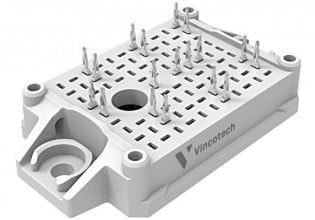The successful development of graphene wafers promises to reduce the cost and increase the performance of electronic devices. This week, IBM's T.J. Watson Research Center announced a new technique for using graphene as a substrate for single-crystalline semiconductor film growth. Replacement of today's SiC substrates with graphene could lead to new applications for GaN and other advanced wide bandgap semiconductor materials. Initial commercial devices could appear in five years or less.
"We have demonstrated direct van der Waals epitaxy of high-quality single-crystalline ​GaN films on epitaxial graphene with low defectivity and surface roughness comparable with that grown on conventional ​SiC or sapphire substrates," stated IBM Research Staff Member and Master Inventor Dr. Jeehwan Kim, with IBM's T.J. Watson Research Center. "The ​GaN film is released and transferred onto arbitrary substrates. The post-released graphene/​SiC substrate is reused for multiple growth and transfer cycles of ​GaN films. We demonstrate fully functional blue light-emitting diodes (LEDs) by growing LED stacks on reused graphene/​SiC substrates followed by transfer onto plastic tapes.
“Since the first demonstrations of removing graphene from graphite a decade ago, the size of a single-oriented piece has been limited to less than a millimeter – far too small for real-world application. Our team worked to break through the original millimeter barrier, and together we found success in producing wafer-scale, single-crystalline sheets of graphene 100 millimeters (four inches) in diameter. Having achieved scalability, we reported the possibility of replacing a thick, “single-crystalline†wafer with a single-atom-thick graphene layer for growing single-crystalline materials in the paper, “Principle of direct van der Waals epitaxy of single-crystalline films on epitaxial graphene†– published with my chief collaborator Dr. Can Bayram in Nature Communications,†Dr. Kim continued.
Carbon Sciences Inc., the developer of a breakthrough technology to mass-produce graphene, the new miracle material, commented on IBM's recent announcement that it is considering replacing silicon with graphene. IBM has developed a new method to use graphene as a substrate for single-crystalline semiconductor film growth. Graphene will be less expensive than current single-crystalline wafers used in such production methods, as it can be reused indefinitely.
IBM says that growing a 4" GaN film today requires a 4" SiC substrate wafer that is destroyed using the process. The SiC costs about $3,000. Graphene can be used to replace the SiC and will be much cheaper in the long run. Graphene is also useful as it is flexible and can be better adapted for films that need to be transferred to a flexible substrate. Carbon Sciences recently announced that it entered into an agreement with the University of California, Santa Barbara (UCSB) to fund the further the development of a new graphene process.
"We are very excited about IBM's sizeable commitment to search for a replacement for silicon and their high level of interest in graphene," said Bill Beifuss, Carbon Sciences' CEO. "Graphene has the potential to become the next-gen chip technology. To unleash its full potential for this application, a more highly controlled and efficient way to produce high quality graphene is needed. Our breakthrough process is intended to transform natural gas into graphene that can be fine-tuned with application-specific electrical and materials properties."
“Graphene holds incredible promise as a linchpin material for breakthroughs in numerous technologies, and my team at IBM’s Thomas J. Watson Research Center is working to make its potential a reality. Due to its incredible strength and supreme electrical, optical and mechanical properties, graphene – pure carbon functional at the thickness of one atom – has been touted as the next big thing in everything from high-frequency transistors and photo-detectors, to flexible electronics and biosensors. IBM is investing $3B over the next five years towards initiatives such as this, which are building a bridge to a “post-silicon†era,†IBM’s Dr. Kim commented.
Part of what makes the material so promising is its strength relative to thickness. At only .3 to .4 nanometers thick (that’s 60,000 times thinner than a sheet of plastic wrap, or 1,000,000 times thinner than a strand of human hair), graphene is an astonishing 200 times stronger than steel. It is also the world’s most conductive material yet discovered, extraordinarily flexible and – as a single layer of carbon atoms – the first two-dimensional material.
“Our groundbreaking approach, known as “graphene-based growth/transfer,†allows single-crystalline semiconductor film growth on graphene – rather than on expensive, single-crystalline wafers. The graphene serves as a “seed†for single-crystalline film growth, and because this film can be separated precisely from the graphene surface, the graphene can be reused for further growth. In principle, graphene has therefore been demonstrated as an infinitive source for growing these semiconductor materials, making the work an enormously cost-effective and reliable production method for single-crystalline films,†Dr. Kim continued.
“Graphene’s periodic hexagonal crystal structure then allowed us to experiment with growing other semiconductor materials that demonstrate similar structural properties. Previously, production of single-crystalline semiconductor films required the use of ~1 millimeter-thick, single-crystalline wafer templates that were not reusable and were very expensive. For example, growth of a 4-inch, wafer-scale GaN (gallium nitride, a direct bandgap semiconductor) film would require a 4-inch SiC wafer – at the cost of some $3000. Now, graphene can be produced in a lab to replace the expensive SiC wafer. Furthermore, the new growth technique is useful in that semiconductor devices can be deposited on graphene and released or transferred to a flexible substrate.
“While we have demonstrated an important, present-day use for this material, the future of graphene as a standalone material is still bright. Uses for graphene are being developed for a number of electronics, and over the next five years, the material could be used as transparent electrodes for touch screen devices, rollable e-paper and foldable LEDs. In the near future, uses are being developed for large-area graphene in high-frequency transistors, logic transistors/thin-film transistors and beyond. Its high electronic mobility – the ability of charged particles to move through a medium in response to an electronic field – makes graphene a promising material,†concluded Dr. Kim.






